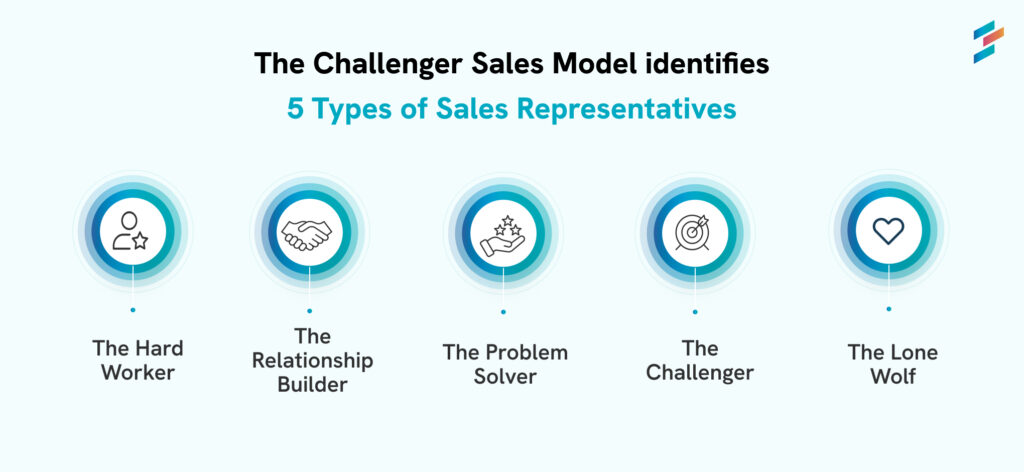58% of sales meetings aren’t important to buyers. Today’s sales reps need to drive conversations and conversions through a deeper understanding of customer challenges and solutions.
Amidst various sales techniques, the Challenger Sales Methodology is known for its forward-thinking approach and proven results. This method, popularized by the book “The Challenger Sale” by Matthew Dixon and Brent Adamson, has transformed how many companies approach their sales process.
In this blog, we’ll cover,
- What is the challenger sales model?
- How does the challenger sales model work?
- The five types of sales reps
- How to adopt the Challenger sales methodology
- Pros and cons of the Challenger sales methodology
Learn more: Complete Guide on Sales Methodologies to Win Large Deals
What is the challenger sales model?
The Challenger Sales Methodology is built around the concept of teaching, tailoring, and taking control. Unlike traditional sales methods that focus heavily on building relationships, the Challenger approach emphasizes the importance of challenging a customer’s thinking, offering unique insights, and pushing them toward a decision.
“Sales organizations can increase business by challenging customers — delivering customer interactions specifically designed to disrupt their current thinking and teach them something new. It’s not just about selling something anymore,” says Brent Adamson, Distinguished Vice President, Advisory, Gartner, and co-author of The Challenger Sale, Taking Control of the Customer Conversation
According to a study by Gartner, Challengers represented nearly 40% of all high-performing sales reps in complex sales environments. Companies that have trained their reps in the Challenger method have seen considerable improvements in customer loyalty and increased sales performance.
Teach for Differentiation
The core idea is to teach customers something new and valuable about how they can compete more effectively. This involves a deep understanding of the customer’s business and presenting solutions that stand out from the competition. Instead of just solving problems, Challengers educate customers on new issues and opportunities they didn’t know existed through novel sales enablement processes.
Tailor for Resonance
Tailoring the message involves customizing the communication to resonate with various stakeholders within the customer’s organization. Challengers adjust their messaging based on the specific customer’s industry, company size, and even individual roles within the company to make it as relevant and impactful as possible.
Take Control of the Sale
Challengers are fearless in asserting the conversation. They take control of the sales process, confidently addressing any concerns or objections. This part of the methodology focuses on maintaining progress toward the sale, especially when discussing pricing and other potentially contentious aspects of the deal
How Does the Challenger Sales Methodology Work?
The Challenger Sales Model adds a layer to the traditional sales approach by adding a dynamic trio of strategies: teaching, tailoring, and taking control. This potent combination is designed to push sales engagements beyond mere transactions into strategic partnerships.
Let’s look into detail at these tactics:
Teaching: Unveiling New Perspectives
Challengers use their knowledge to educate customers about business problems and insights they might have overlooked.
For example, a sales rep in the tech industry might highlight how adopting advanced cybersecurity solutions can enhance a company’s security and reduce operational costs. According to a Gartner report, companies can experience up to a 30% reduction in IT operational costs with the right technological investments.
Tailoring: Crafting Personalized Messages
Tailoring involves customizing communication to resonate with different stakeholders within the customer’s organization.
For instance, when discussing a new cloud computing solution, the sales rep might emphasize cost efficiency and scalability to the CFO, while highlighting ease of integration to the CTO.
This tailored approach ensures that each stakeholder understands the value of the solution from their perspective, increasing overall buy-in.
Taking Control: Leading the Conversation
Taking control means confidently navigating the sales conversation, especially during price negotiations or when addressing objections.
For instance, when a client is concerned about the cost of new equipment, a Challenger might shift the focus to the ROI and long-term savings provided by the equipment. Research from Forrester indicates that well-presented ROI data can significantly influence purchasing decisions
The Five Types of Sales Reps
The Challenger model identifies five types of sales representatives, each with distinct traits and approaches. Understanding these types can help organizations better deploy their sales teams and refine their strategies

1. The Hard Worker
The Hard Worker consistently puts in effort and shows dedication to their tasks. They are always ready to take on extra work and strive to meet their targets. However, they may rely too much on effort alone to close deals, which can lead to burnout or missed opportunities when strategic thinking is needed.
For example, a Hard Worker might make numerous cold calls daily but might not spend enough time researching the prospects beforehand.
2. The Relationship Builder
The Relationship Builder excels at creating and maintaining connections with clients. They prioritize building trust and rapport, which can be beneficial in maintaining long-term relationships.
However, they might lack the assertiveness needed to challenge customers effectively. For instance, a Relationship Builder might hesitate to push back on a client’s outdated practices, even if it means the client misses out on better solutions.
3. The Lone Wolf
The Lone Wolf relies on their instincts and prefers to work independently. They often disregard standard procedures and protocols, which can lead to both great successes and notable failures.
This type of rep might close a big deal by taking unconventional approaches, but they can also create challenges for team cohesion and consistency in sales practices.
For example, a Lone Wolf might secure a major account by bypassing the usual approval process, but this could cause issues later on when the account needs to be managed within the standard framework.
4. The Problem Solver
The Problem Solver focuses on resolving client issues and ensuring satisfaction. They are meticulous in addressing concerns and providing solutions. However, they might become too involved in post-sale activities.
This can detract from their ability to generate new business. For example, a Problem Solver might spend significant time troubleshooting a client’s issues, potentially neglecting opportunities to pursue new leads or upsell existing clients.
5. The Challenger
The Challenger thrives in complex sales environments by understanding customer needs and challenging their thinking. They use their industry knowledge to provide unique insights and drive conversations that lead to sales.
Challengers are comfortable taking control of the discussion and addressing objections directly. For example, a Challenger might present a potential client with data on industry trends that the client was unaware of, demonstrating the necessity of the proposed solution and pushing the client toward making a decision.
How to Adopt the Challenger Sales Methodology
Implementing the Challenger Sales Model involves a series of structured steps. These steps help sales teams transition smoothly to this new approach, ensuring they are prepared to challenge clients effectively.
Training
Start by equipping your team with the skills necessary to understand and execute the Challenger techniques. This involves comprehensive training sessions where sales reps learn the principles of teaching, tailoring, and taking control.
Use case studies and real-world examples to illustrate how these techniques work in practice. For instance, you might present scenarios where a Challenger successfully navigated a complex sale by addressing a customer’s previously unrecognized pain points.
Ensure that your training covers not only the theoretical aspects but also practical applications.
Practice
Regular role-playing sessions are essential for mastering the art of challenging and tailoring conversations. These sessions allow sales reps to practice their skills in a controlled environment, receiving immediate feedback on their performance.
Set up scenarios that mimic real-life sales situations, where reps must identify customer needs, provide insightful solutions, and handle objections confidently. Encourage them to practice both common and difficult scenarios to build their competence and confidence.
For example, have them role-play a situation where they need to convince a skeptical client about the benefits of a new solution.
Support
Ongoing coaching and feedback are crucial to refining the approaches and techniques used by the sales team. Provide regular one-on-one coaching sessions where managers can discuss specific challenges reps are facing and offer targeted advice.
Use performance metrics to track progress and identify areas for improvement. For example, analyze sales call recordings to pinpoint where a rep might improve their questioning techniques or how they handle objections.
Continuous feedback helps reps adjust their strategies and enhances their ability to apply the Challenger methodology effectively.
Implementation in Stages
Implement the Challenger Sales Model in stages to ensure a smooth transition. Start with a pilot group to test the approach and gather feedback. This group can refine the process before rolling it out to the entire team.
Monitor the results closely, looking at metrics like conversion rates, deal sizes, and customer feedback. Use this data to make any necessary adjustments and to demonstrate the model’s effectiveness to the rest of the team.
Integration with Existing Processes
Integrate the Challenger methodology with your existing sales processes and tools. Ensure that your CRM and other sales tools support the new approach, allowing reps to track their interactions and insights efficiently.
For example, customize your CRM to include fields for capturing teaching moments and tailored messages. This integration helps maintain consistency and ensures that all team members are aligned with the new methodology.
Pros and Cons of the Challenger Sales Methodology
Pros
- Challengers provide insights and value, encouraging more meaningful conversations with clients.
- By understanding client needs and challenges deeply, sales reps can identify additional opportunities to offer relevant solutions.
- Challengers build trust by challenging the status quo and providing valuable insights, leading to stronger, long-term relationships.
- The approach helps stand out in crowded markets by offering unique perspectives and solutions that others may not provide.
- Particularly effective in B2B settings where buyers face complex decisions, the Challenger approach can navigate these intricacies more effectively.
Cons
- Teams with varying levels of experience and comfort with the approach may struggle to adopt it uniformly.
- Sales reps accustomed to relationship-based or product-based selling might resist changing their approach.
- In some markets, customers may prefer traditional relationship-building approaches over being challenged.
- The in-depth conversations and educational approach can extend the sales process, which might be a drawback in fast-paced sales environments.
How Tools Like DemandFarm Can Help Implementing the Challenger Sales Method
DemandFarm’s key account management software integrates seamlessly with Salesforce, leveraging the platform’s features to enhance account management processes. This integration provides real-time market knowledge, decision-making capabilities, and advantages across strategic account portfolios.

DemandFarm’s Scorecard helps you standardize the sales process for your deals and enforce best practices. With DemandFarm, a leader in the key account management space, you also get access to features like
- Win probability based on adherence to your preferred sales methodology
- A recommendation engine that alerts your team about pending stages and opportunities at risk
- Out-of-the-box dashboards for pipeline opportunities
- Playbooks to record and track stakeholder engagement for large deal management
- Stage-independent scorecards for organizations that follow custom variations of popular sales frameworks
- A 100% SF-native suite guaranteeing seamless two-way data sync
Conclusion
The Challenger Sales Methodology offers a robust framework for rethinking how sales are done in complex B2B transactions. Sales professionals can unlock new opportunities and drive significant growth by focusing on teaching, tailoring, and taking control. Whether you’re just starting or looking to refine existing processes, the Challenger sales method provides the tools to transform your sales strategy, go the extra mile, and achieve outstanding results.
Tools like DemandFarm can enhance the effectiveness of sales methodologies, including the Challenger Sales Model, by integrating account management processes with real-time data and analytics. This integration helps sales teams manage key accounts, identify growth opportunities, and optimize sales cycles, ultimately driving revenue growth and improving strategic account management.
Are you ready to maximize your win rates and accelerate your deal velocity? If you’re interested in learning how you can engineer excellence into your sales cycle, get in touch with us for a demo.

